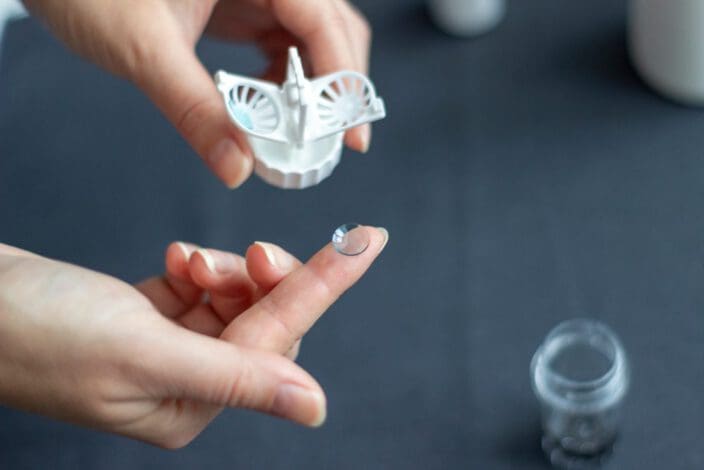Further Reading
Are Cheap Contacts Worth It? (The Truth)
Home / Understanding Contacts /
Last Updated:
Contact lenses can enhance your vision in a convenient way. You do not have to worry about wearing glasses all the time, and there are numerous contact types to choose from.
Table of Contents
Contact prices vary, depending on the type of contact and the brand. While cheap contacts are available, they aren’t always the best choice for your eyes. A low-quality pair may be more likely to tear, and this could lead to a scratch on your cornea or other damage to the eye.
After exploring the price points for different brands and types of contacts, you can determine how much you need to spend to get a good pair.
Pros and Cons of Expensive vs. Cheap Contacts

Daily contacts tend to be more costly due to the fact that you wear a new pair every day. Monthly contacts are more cost-effective because you only need to purchase one pair each month.
The following are the benefits of daily contacts, which tend to be more expensive:
You deserve clear vision. We can help.
With 135+ locations and over 2.5 million procedures performed, our board-certified eye surgeons deliver results you can trust. Your journey to better vision starts here.
- They can be more convenient because you do not have to worry about cleaning and storing them.
- Buildup is usually not a problem because you are only wearing them for a day. This can be a good choice if you have allergies or sensitive eyes.
- You do not have to keep track of how many days you have worn them because you always use a new pair each day.
- If your child is new to contacts, dailies are ideal since they require less care. Also, if they accidentally rip a contact when putting it in or removing it, they can just replace it with another pair.
The cons of daily contacts include the following:
- You can’t sleep in them since this can result in eye damage.
- The cost is higher.
- They are not as environmentally friendly.
- Compared to monthly contacts, dailies tend to be more delicate.
The following pros are associated with monthly contacts, which tend to be cheaper:
- They usually cost less.
- You can sleep in some of them, through it is not recommended that you do this often. You should only sleep in those that are listed as extended wear.
- They are more environmentally friendly since you are only replacing them monthly
- Your eyes get more oxygen due to the silicone gel component of these contacts.
The cons of monthly contacts include the following:
- You usually need more supplies, so you can keep them clean and maintained.
- There is a higher risk of buildup accumulating on the lenses.
- It is easier to wear this type of contact lens for too long.
- If you need to replace them prematurely, the cost can add up.
Are Expensive Contacts Better?

Talk to your optometrist about the cheapest contact lenses that will work well for your situation. This ensures you can still get the quality vision correction you need without spending a bundle.
Expensive contacts aren’t necessarily better, though some more expensive options may provide features you need that are worth the extra cost.
Daily vs. Monthly
Daily contacts tend to be the soft type. This makes them more prone to tearing compared to monthly contacts, which are usually higher in quality since they need to last you at least a month. But remember you are paying more for dailies for the ease of use and reduced risk of infections and other issues.
Overall, the lenses are not that much different between daily and monthly options. You usually have choices regarding features and materials.
If you choose a soft lens, silicone hydrogel is likely what you will get. In the United States, about 62 percent of soft contacts are made from this material. It is very absorbent and allows more oxygen to get past the contact to your eye. Due to this feature, your eyes tend to be more comfortable and less prone to irritation and dryness throughout the day.
For monthly lenses, you can choose a soft lens or one that is more rigid, so you have a little more flexibility regarding the type of contact you wear. One common option is the gas permeable contact lens. They are rigid, but due to their permeability, oxygen is still able to get through so your eyes do not feel dry and irritated. Compared to other hard lenses, they are more comfortable.
Gas permeable lenses tend to provide sharper vision than lenses that are soft and made from silicone hydrogel. If you have astigmatism, they are generally the better choice since they are harder. Just know that it can take a little while for your eyes to adjust to this type of lens.
In terms of price, gas permeable lenses usually fall on the more expensive end of the spectrum.
You deserve clear vision. We can help.
With 135+ locations and over 2.5 million procedures performed, our board-certified eye surgeons deliver results you can trust. Your journey to better vision starts here.
What Are the Price Ranges for Contacts?

When you are considering the cost of contact lenses, you have to think about the contacts themselves, as well as a fitting and eye examination. You should get an eye examination as frequently as your doctor recommends to ensure you are always wearing a current prescription.
Looking at the cost of the contacts themselves, the average range is $25 to $500 per box or lens, though some are priced per lens instead of per pair.
If you have vision insurance, they will likely cover some of the cost. However, you have to make sure they cover the type of contact lens you prefer. Some plans have stipulations regarding the contact lenses they will cover. Vision insurance also typically provides at least partial coverage for at least one eye examination each year.
If you are on a budget, it is a good idea to shop around to see where you can get the best deals. Just make sure you buy your contacts from a reputable retailer so they are high in quality.
How Much Should You Spend on Your Contacts?
There isn’t a set amount you should spend on contact lenses since the type of lens you need will be individual.
It’s important to choose a pair that is comfortable and ideal for your vision issues. For example, if you have astigmatism, you want to look at harder contacts since these will often offer the greatest vision improvement. There are also hybrid lenses that are sometimes recommended, but these tend to be more expensive than other types of lenses.
Contact your insurance company to see which types of contact lenses they will cover and the extent of your coverage. This gives you a place to start regarding the lenses that are available to you and their average cost. From here, you can create a more accurate budget.
If your budget is tighter, a monthly lens is often the less expensive choice. You also need to factor in the cost of contact solution.
Next, consider the cost of the eye examination so you can get an accurate prescription. The cost of the exam can range from $50 to $300. Your insurance company may cover some of this.
What About Discount Sites?
Many retailers offer sales on contact lenses, and it’s wise to take advantage of these.
Stay away from sketchy operations that offer prices that seem too good to be true — they likely are. If a site doesn’t require a valid prescription from an optometrist, they are probably a scam site.
You deserve clear vision. We can help.
With 135+ locations and over 2.5 million procedures performed, our board-certified eye surgeons deliver results you can trust. Your journey to better vision starts here.
References
- You Asked: What Type of Contact Lenses Should I Wear? (July 2017). Time.
- Types of Contact Lenses. (January 2018). Food and Drug Administration.
- Today’s Contact Lens Materials and Designs. (August 2017). Review of Optometry.
- Which Is Better for Astigmatism – Glasses or Contacts? (July 2015). American Academy of Ophthalmology.
- The Cost of Contact Lenses. (May 2019). Verywell Health.
This content is for informational purposes only. It may have been reviewed by a licensed physician, but is not intended to serve as a substitute for professional medical advice. Always consult your healthcare provider with any health concerns. For more, read our Privacy Policy and Editorial Policy.